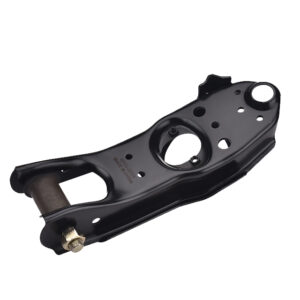A control arm, also known as an A-arm or wishbone, plays a vital role in contributing to the stability and handling of a vehicle.
Here's how a control arm affects these aspects:
Suspension Geometry: Control arms are crucial components of a vehicle's suspension system and help establish the suspension geometry. They control the motion of the wheels, allowing them to move up and down within a specified range. Proper suspension geometry, facilitated by control arms, ensures that the tires maintain better alignment with the road surface, promoting stability and handling.
Wheel Movement Control: Control arms help control the vertical movement of the wheels. They connect the suspension components, such as the steering knuckle or hub assembly, to the vehicle's chassis or subframe. By guiding the wheels' motion, control arms reduce excessive bouncing, vibrations, and oscillations. This contributes to a smoother ride, improved handling, and enhanced stability during acceleration, braking, and cornering.
Camber Control: Control arms also influence the camber angle, which is the vertical tilt of the wheels when viewed from the front. Proper camber alignment is crucial for tire contact with the road surface. Control arms with adjustable camber settings allow for fine-tuning the suspension geometry, optimizing tire grip during turns, and improving stability and cornering performance.
Caster Control: The caster angle refers to the forward or backward tilt of the steering axis when viewed from the side. Control arms, particularly the upper control arm, play a role in controlling the caster angle. The caster angle affects steering stability, self-centering ability, and straight-line tracking. car control arm Manufacturers in China Proper caster alignment, facilitated by control arms, contributes to better stability and handling characteristics.
Impact Absorption: Control arms, along with other suspension components, help absorb and distribute the impact forces when encountering bumps, potholes, or road irregularities. By dampening these impacts, control arms contribute to a more controlled and stable ride, reducing the likelihood of losing traction or experiencing instability.
In summary, control arms are integral to a vehicle's suspension system and significantly impact stability and handling. They control wheel movement, establish suspension geometry, influence camber and caster angles, and aid in impact absorption. Regular inspections and maintenance of control arms are essential to ensure their proper function and contribute to a safe and enjoyable driving experience.
What are the different types of control arms used in cars?
There are several different types of control arms used in cars, depending on the specific suspension design and configuration.
Suspension Geometry: Control arms are crucial components of a vehicle's suspension system and help establish the suspension geometry. They control the motion of the wheels, allowing them to move up and down within a specified range. Proper suspension geometry, facilitated by control arms, ensures that the tires maintain better alignment with the road surface, promoting stability and handling.
Wheel Movement Control: Control arms help control the vertical movement of the wheels. They connect the suspension components, such as the steering knuckle or hub assembly, to the vehicle's chassis or subframe. By guiding the wheels' motion, control arms reduce excessive bouncing, vibrations, and oscillations. This contributes to a smoother ride, improved handling, and enhanced stability during acceleration, braking, and cornering.
Camber Control: Control arms also influence the camber angle, which is the vertical tilt of the wheels when viewed from the front. Proper camber alignment is crucial for tire contact with the road surface. Control arms with adjustable camber settings allow for fine-tuning the suspension geometry, optimizing tire grip during turns, and improving stability and cornering performance.
Caster Control: The caster angle refers to the forward or backward tilt of the steering axis when viewed from the side. Control arms, particularly the upper control arm, play a role in controlling the caster angle. The caster angle affects steering stability, self-centering ability, and straight-line tracking. car control arm Manufacturers in China Proper caster alignment, facilitated by control arms, contributes to better stability and handling characteristics.
Impact Absorption: Control arms, along with other suspension components, help absorb and distribute the impact forces when encountering bumps, potholes, or road irregularities. By dampening these impacts, control arms contribute to a more controlled and stable ride, reducing the likelihood of losing traction or experiencing instability.
In summary, control arms are integral to a vehicle's suspension system and significantly impact stability and handling. They control wheel movement, establish suspension geometry, influence camber and caster angles, and aid in impact absorption. Regular inspections and maintenance of control arms are essential to ensure their proper function and contribute to a safe and enjoyable driving experience.
What are the different types of control arms used in cars?
There are several different types of control arms used in cars, depending on the specific suspension design and configuration.
Here are some common types:
Upper Control Arms: Found in many independent front suspension systems, upper control arms connect the upper part of the steering knuckle or hub assembly to the vehicle's chassis or subframe. They help control the vertical movement of the wheel and contribute to camber and caster adjustments.
Lower Control Arms: Lower control arms are also part of independent front suspension systems. They connect the lower part of the steering knuckle or hub assembly to the vehicle's chassis or subframe. Lower control arms play a crucial role in controlling the vertical movement of the wheel and provide stability and support.
Wishbone Control Arms: Wishbone control arms, also known as A-arms or double wishbones, have two attachment points at the chassis or subframe and one at the steering knuckle or hub assembly. Wishbone control arms offer improved suspension geometry and allow for better control of wheel movement, contributing to enhanced handling and stability.
Lateral Control Arms: Lateral control arms, also called track control arms or transverse links, control the side-to-side movement of the suspension. They connect the chassis or subframe to the steering knuckle or hub assembly and help maintain proper alignment and control during cornering.
Trailing Arms: Trailing arms are commonly found in rear suspension systems, particularly in multi-link or trailing arm setups. They connect the rear axle or subframe to the chassis and assist in controlling rear wheel movement, contributing to stability and handling characteristics.
Radius Arms: Radius arms, also known as torque arms or trailing arms, are used in specific suspension setups, such as leaf spring or solid axle designs. They help control the torque and rotational movement of the axle, maintaining alignment and stability.
It's important to note that the specific types of control arms used in a car can vary depending on the make, model, and suspension system design. Additionally, some vehicles may utilize a combination of different control arm types to achieve desired suspension characteristics.
Upper Control Arms: Found in many independent front suspension systems, upper control arms connect the upper part of the steering knuckle or hub assembly to the vehicle's chassis or subframe. They help control the vertical movement of the wheel and contribute to camber and caster adjustments.
Lower Control Arms: Lower control arms are also part of independent front suspension systems. They connect the lower part of the steering knuckle or hub assembly to the vehicle's chassis or subframe. Lower control arms play a crucial role in controlling the vertical movement of the wheel and provide stability and support.
Wishbone Control Arms: Wishbone control arms, also known as A-arms or double wishbones, have two attachment points at the chassis or subframe and one at the steering knuckle or hub assembly. Wishbone control arms offer improved suspension geometry and allow for better control of wheel movement, contributing to enhanced handling and stability.
Lateral Control Arms: Lateral control arms, also called track control arms or transverse links, control the side-to-side movement of the suspension. They connect the chassis or subframe to the steering knuckle or hub assembly and help maintain proper alignment and control during cornering.
Trailing Arms: Trailing arms are commonly found in rear suspension systems, particularly in multi-link or trailing arm setups. They connect the rear axle or subframe to the chassis and assist in controlling rear wheel movement, contributing to stability and handling characteristics.
Radius Arms: Radius arms, also known as torque arms or trailing arms, are used in specific suspension setups, such as leaf spring or solid axle designs. They help control the torque and rotational movement of the axle, maintaining alignment and stability.
It's important to note that the specific types of control arms used in a car can vary depending on the make, model, and suspension system design. Additionally, some vehicles may utilize a combination of different control arm types to achieve desired suspension characteristics.







